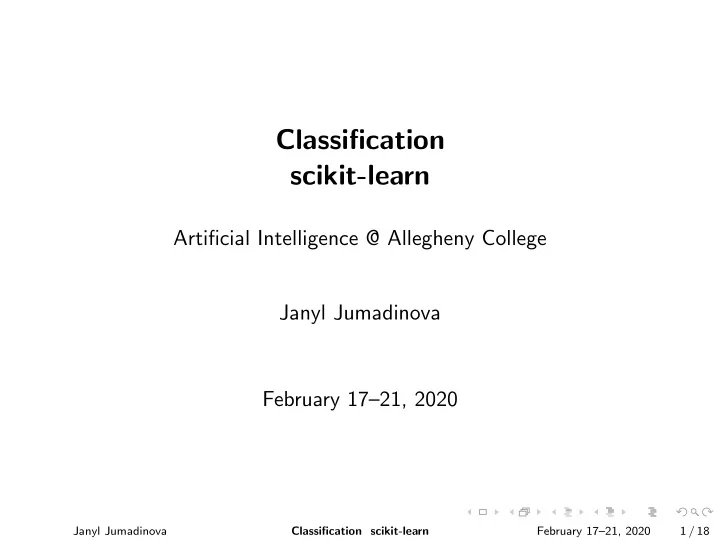

Classification scikit-learn Artificial Intelligence @ Allegheny College Janyl Jumadinova February 17–21, 2020 Janyl Jumadinova February 17–21, 2020 1 / 18 Classification scikit-learn
scikit-learn Popular Python machine learning library Designed to be a well documented and approachable for non-specialist Built on top of NumPy and SciPy scikit-learn can be easily installed with pip or conda pip install scikit-learn conda install scikit-learn Janyl Jumadinova February 17–21, 2020 2 / 18 Classification scikit-learn
Data representation in scikit-learn Training dataset is described by a pair of matrices, one for the input data and one for the output. Most commonly used data formats are a NumPy ndarray or a Pandas DataFrame / Series . Janyl Jumadinova February 17–21, 2020 3 / 18 Classification scikit-learn
Data representation in scikit-learn Training dataset is described by a pair of matrices, one for the input data and one for the output. Most commonly used data formats are a NumPy ndarray or a Pandas DataFrame / Series . Each row of these matrices corresponds to one sample of the dataset. Each column represents a quantitative piece of information that is used to describe each sample (called “features”). Janyl Jumadinova February 17–21, 2020 3 / 18 Classification scikit-learn
Data representation in scikit-learn image credit: James Bourbeau Janyl Jumadinova February 17–21, 2020 4 / 18 Classification scikit-learn
Features in scikit-learn feature Module https://scikit-image.org/docs/dev/api/skimage.feature.html Janyl Jumadinova February 17–21, 2020 5 / 18 Classification scikit-learn
Local Binary Pattern Feature Extraction Introduced by Ojala et. al in “Multiresolution Gray Scale and Rotation Invariant Texture Classificationwith Local Binary Patterns” 1 Check whether the points surrounding the central point are greater than or less than the central point → get LBP codes (stored as array). 2 Calculate a histogram of LBP codes as a feature vector. image credit: https://scikit-image.org/docs/dev/auto_examples/features_detection/plot_local_binary_pattern.html Janyl Jumadinova February 17–21, 2020 6 / 18 Classification scikit-learn
Local Binary Pattern Feature Extraction Example: The histogram of the LBP outcome is used as a measure to classify textures. image credit: https://scikit-image.org/docs/dev/auto_examples/features_detection/plot_local_binary_pattern.html Janyl Jumadinova February 17–21, 2020 7 / 18 Classification scikit-learn
Estimators in scikit-learn Algorithms are implemented as estimator classes in scikit-learn . Each estimator in scikit-learn is extensively documented (e.g. the KNeighborsClassifier documentation) with API documentation, user guides, and example usages. A model is an instance of one of these estimator classes Janyl Jumadinova February 17–21, 2020 8 / 18 Classification scikit-learn
Training a model fit then predict # Fit the model model.fit(X, y) # Get model predictions y_pred = model.predict(X) Janyl Jumadinova February 17–21, 2020 9 / 18 Classification scikit-learn
Decision Tree in scikit-learn image credit: James Bourbeau Janyl Jumadinova February 17–21, 2020 10 / 18 Classification scikit-learn
Model performance metrics Many commonly used performance metrics are built into the metrics subpackage in scikit-learn. However, a user-defined scoring function can be created using the sklearn.metrics.make scorer function. Janyl Jumadinova February 17–21, 2020 11 / 18 Classification scikit-learn image credit: James Bourbeau
Separate training and testing sets scikit-learn has a convenient train test split function that randomly splits a dataset into a testing and training set. image credit: James Bourbeau Janyl Jumadinova February 17–21, 2020 12 / 18 Classification scikit-learn
Model selection - hyperparameter optimization Model hyperparameter values (parameters whose values are set before the learning process begins) can be used to avoid under- and over-fitting. Janyl Jumadinova February 17–21, 2020 13 / 18 Classification scikit-learn
Model selection - hyperparameter optimization Model hyperparameter values (parameters whose values are set before the learning process begins) can be used to avoid under- and over-fitting. Under-fitting - model isn’t sufficiently complex enough to properly model the dataset at hand. Over-fitting - model is too complex and begins to learn the noise in the training dataset. Janyl Jumadinova February 17–21, 2020 13 / 18 Classification scikit-learn image
k-fold cross validation Cross-validation is a resampling procedure used to evaluate machine learning models on a limited data sample. It uses a limited sample in order to estimate how the model is expected to perform in general when used to make predictions on data not used during the training of the model. The parameter k refers to the number of groups that a given data sample is to be split into. Janyl Jumadinova February 17–21, 2020 14 / 18 Classification scikit-learn
k-fold cross validation 1. Shuffle the dataset randomly. 2. Split the dataset into k groups. 3. For each unique group: 3.1. Take the group as a hold out or test data set. 3.2. Take the remaining groups as a training data set. 3.3. Fit a model on the training set and evaluate it on the test set. 3.4. Retain the evaluation score and discard the model. 4. Summarize the skill of the model using the sample of model evaluation scores. Janyl Jumadinova February 17–21, 2020 15 / 18 Classification scikit-learn
k-fold cross validation image credit: https://scikit-learn.org/stable/modules/cross_validation.html Janyl Jumadinova February 17–21, 2020 16 / 18 Classification scikit-learn
k-fold cross validation image credit: James Bourbeau Janyl Jumadinova February 17–21, 2020 17 / 18 Classification scikit-learn
Cross Validation in scikit-learn image credit: James Bourbeau Janyl Jumadinova February 17–21, 2020 18 / 18 Classification scikit-learn
Recommend
More recommend